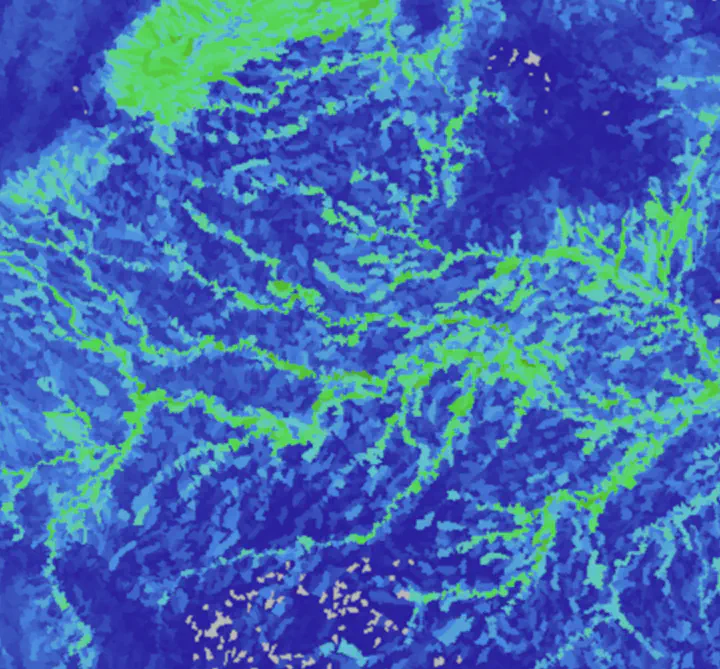SSP projections of landcover and fish
A workflow for downscaling SSP storylines and modelling fish distributions
 Modelled fish richness in South America (Brunner et al., unpublished)
Modelled fish richness in South America (Brunner et al., unpublished)
Thesis topic: Influence of land-cover on suitable fish habitats in Colombia’s inland waters considering the “Shared Socioeconomic Pathway (SSP)” scenarios
» Dowload the publication as a pdf «
» Click here for the visualization «
Freshwater ecosystems are becoming increasingly degraded and freshwater species diversity is declining drastically. Anthropological influences, such as land-cover change, play an important role in these processes. In Latin America, freshwater fish show high rates of diversity and endemism. At the same time, ecosystems in Latin America are threatened by high rates of land-cover change. Therefore, Colombia, endowed with a great habitat diversity and species richness due to a combination of altitude, climate and geographic location, but also distinct land-cover dynamics, was chosen as a case study for this work.
The objective of the thesis was (i) to consider the land-cover types prevalent, past trends of land-cover change and future land-cover changes projected according to the shared socioeconomic pathway scenarios (SSPs) (ii) to discern the influence of environmental factors, including land-cover, on suitable habitats of Colombian fish species and (iii) to project the possible future development of fish habitats and species richness. The main tools used for these analysis were land-cover modelling (with Dinamica EGO) and species distribution modelling (with BIOMOD).
The analysis of past land-cover changes shows that factors such as demand or policies contribute to both increases and decreases in agricultural land expansion and deforestation and also that trends are not stable. The land-cover projections are driven by population development, nutrition or technological progress assumptions incorporated in the SSP scenarios and thus represent the trends of “Sustainability” (SSP1), “Middle of the road” (SSP2), “Regional rivalry” (SSP3), “Inequality” (SSP4) or “Fossil-fueled development” (SSP5).
The projected landcover change for a larger window of Colombia until 2070 following the SSP1 storyline:
Across all 1,209 modelled fish species, models suggest that until 2050 and 2070 species richness in the study area will increase and spatial expansion of suitable habitats will occur. Land-cover, unlike climate, had a poor contribution to the projection of changes in habitat development and species richness. As a function of present temperature and precipitation in projected suitable habitats, future habitats of species in presently warmer habitats are projected to have more area, higher elevation on average and lower flow accumulation, than species with lower mean present habitat temperatures. For the Colombian endemic species (n=219) analysed - more likely projected in lower-temperature sub-catchments - the species distribution model projects stagnating future richness, decreasing habitat area, a shift to higher elevated habitats as well as higher extinction rates compared to non-endemic species.
Migration, expansion or extinction of certain fish species, caused, altered or accelerated by changes in environmental conditions, for example by climate change, are likely to affect the composition, diversity, function, and services of fish communities, further impacting the whole freshwater ecosystem and also structures and systems beyond. Projecting potential future environmental changes and species distributions through models can accordingly help identify factors that may affect species populations or locate places where threats to certain species are particularly high so that appropriate conservation planning steps can be taken.